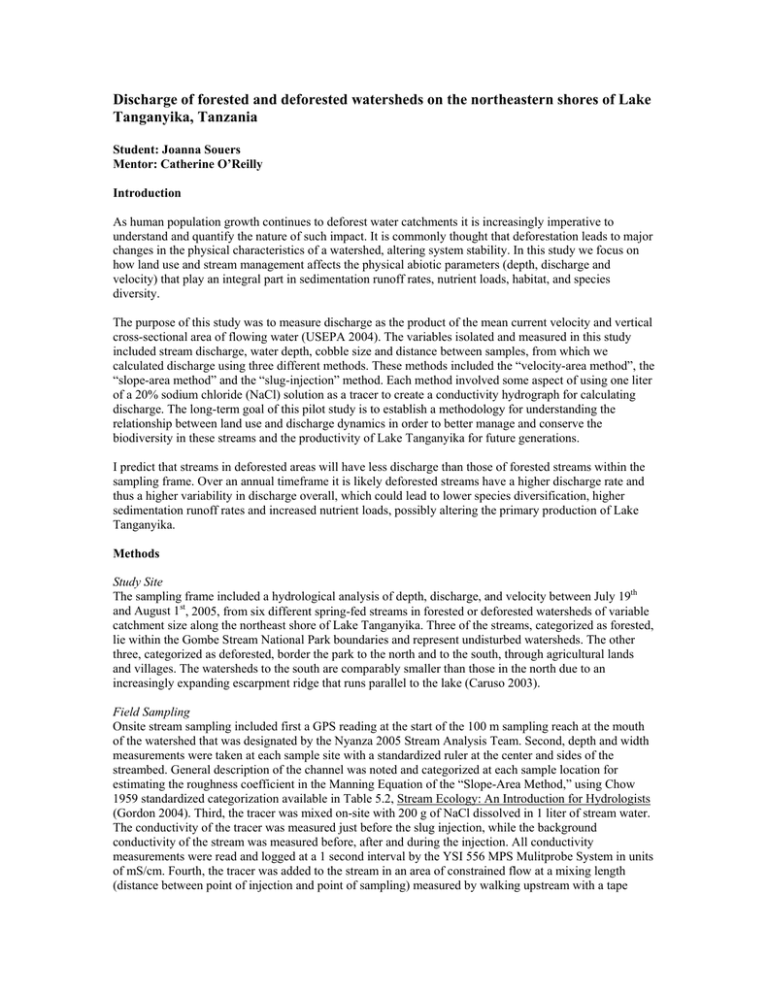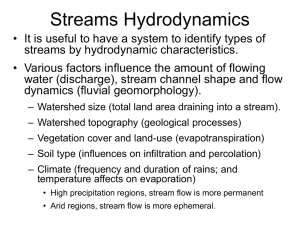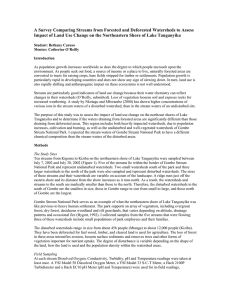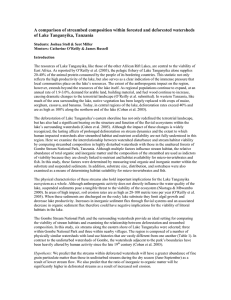Discharge of forested and deforested watersheds on the northeastern shores... Tanganyika, Tanzania
advertisement

Discharge of forested and deforested watersheds on the northeastern shores of Lake Tanganyika, Tanzania Student: Joanna Souers Mentor: Catherine O’Reilly Introduction As human population growth continues to deforest water catchments it is increasingly imperative to understand and quantify the nature of such impact. It is commonly thought that deforestation leads to major changes in the physical characteristics of a watershed, altering system stability. In this study we focus on how land use and stream management affects the physical abiotic parameters (depth, discharge and velocity) that play an integral part in sedimentation runoff rates, nutrient loads, habitat, and species diversity. The purpose of this study was to measure discharge as the product of the mean current velocity and vertical cross-sectional area of flowing water (USEPA 2004). The variables isolated and measured in this study included stream discharge, water depth, cobble size and distance between samples, from which we calculated discharge using three different methods. These methods included the “velocity-area method”, the “slope-area method” and the “slug-injection” method. Each method involved some aspect of using one liter of a 20% sodium chloride (NaCl) solution as a tracer to create a conductivity hydrograph for calculating discharge. The long-term goal of this pilot study is to establish a methodology for understanding the relationship between land use and discharge dynamics in order to better manage and conserve the biodiversity in these streams and the productivity of Lake Tanganyika for future generations. I predict that streams in deforested areas will have less discharge than those of forested streams within the sampling frame. Over an annual timeframe it is likely deforested streams have a higher discharge rate and thus a higher variability in discharge overall, which could lead to lower species diversification, higher sedimentation runoff rates and increased nutrient loads, possibly altering the primary production of Lake Tanganyika. Methods Study Site The sampling frame included a hydrological analysis of depth, discharge, and velocity between July 19th and August 1st, 2005, from six different spring-fed streams in forested or deforested watersheds of variable catchment size along the northeast shore of Lake Tanganyika. Three of the streams, categorized as forested, lie within the Gombe Stream National Park boundaries and represent undisturbed watersheds. The other three, categorized as deforested, border the park to the north and to the south, through agricultural lands and villages. The watersheds to the south are comparably smaller than those in the north due to an increasingly expanding escarpment ridge that runs parallel to the lake (Caruso 2003). Field Sampling Onsite stream sampling included first a GPS reading at the start of the 100 m sampling reach at the mouth of the watershed that was designated by the Nyanza 2005 Stream Analysis Team. Second, depth and width measurements were taken at each sample site with a standardized ruler at the center and sides of the streambed. General description of the channel was noted and categorized at each sample location for estimating the roughness coefficient in the Manning Equation of the “Slope-Area Method,” using Chow 1959 standardized categorization available in Table 5.2, Stream Ecology: An Introduction for Hydrologists (Gordon 2004). Third, the tracer was mixed on-site with 200 g of NaCl dissolved in 1 liter of stream water. The conductivity of the tracer was measured just before the slug injection, while the background conductivity of the stream was measured before, after and during the injection. All conductivity measurements were read and logged at a 1 second interval by the YSI 556 MPS Mulitprobe System in units of mS/cm. Fourth, the tracer was added to the stream in an area of constrained flow at a mixing length (distance between point of injection and point of sampling) measured by walking upstream with a tape measurer. This was then repeated upstream at the end of the 100 m reach and at a variable distance upstream between 100-500 m, depending on the watershed. Distance between sample sites was recorded using the measured transects, a tape measurer or the GPS reading. Each sample was labeled with stream number in order of sampling, and the relative location, starting with “A” downstream (i.e. “Stream 1A,” was the first sample downstream at the first stream sampled). Results of this sampling are available in Table 1. Global Logger Installation A Global Water WL15 Level Logger that measures water depth at half-hour intervals was installed in the Kasekera stream located in Gombe National Park for year-round data collection of water depth as well as discharge analysis. Statistical Analysis Statistical Analysis, using a fit model for fit least squares and effect tests, measured the probability in variance of discharge between catchment size and status. Student’s t-test for analyzing the mean was used to test the significance of difference between the three methods. Results Stream Name Ngonya Status Deforested Area (sq km) 7.3 Depth (cm) 16 Width (cm) 259 Velocity (m/s) 1.47 Discharge1 (m3/s) 0.020 Discharge2 (m3/s) 0.398 Discharge3 (m3/s) 0.03 Rutanga Forested 2.4 15 230 0.87 0.014 0.188 0.04 Mkenke Forested 2.5 11 72 0.39 0.004 0.021 0.04 Kalande Forested 1.7 13 160 1.16 0.016 0.190 0.03 Ngelwa Deforested 0.4 6 53 0.22 0.001 0.003 0.02 Mtanga Deforested 5.8 12 87 0.51 0.010 0.030 0.02 Table 1. Values in the above table are the calculated averages of at least two samples per site within the first 100 m reach and one up to 500 m upstream. The sites are listed north to south by the local names of the streams. Note: Discharge1 corresponds to the “slug-injection” method, Discharge2 corresponds to the “dilution” or velocity-area method, and Discharge3 corresponds to the Manning Equation or slope-area method. Watershed areas calculated by Josh Stoll (2005). Discussion Student’s t-test for testing the mean shows a p-value of less than 0.0001, supporting a significant difference between the three methods of measuring discharge. A supporting Multivariate Test of correlation between the different measurements of discharge and the parameters used to measure them shows a strong correlation between the first method and velocity (r2 = 0.9474) and depth (r2 = 0.8123), while methods two and three show no strong correlations (Table 2). These statistical results lead us to reason that the “slug injection” method was the most accurate method, out of the three tested, for measuring discharge. We used the results of this method to further analyze our data. Catchment Size (Sq km) 1.0000 Depth (cm) Width (cm) Velocity (m/s) Discharge1 (m3/s) Discharge2 (m3/s) Discharge3 (m3/s) Catchment 0.9415 0.8666 0.9804 0.9896 0.9737 0.4916 Size (Sq km) Depth (cm) 0.9415 1.0000 0.6877 0.9206 0.9253 0.8566 0.6713 Width (cm) 0.8666 0.6877 1.0000 0.8115 0.8533 0.9553 0.3661 Velocity 0.9804 0.9206 0.8115 1.0000 0.9869 0.9424 0.4048 (m/s) Discharge1 0.9896 0.9253 0.8533 0.9869 1.0000 0.9646 0.4560 (m3/s) Discharge2 0.9737 0.8566 0.9553 0.9424 0.9646 1.0000 0.4331 (m3/s) Discharge3 0.4916 0.6713 0.3661 0.4048 0.4560 0.4331 1.0000 (m3/s) Table 2. Multivariate correlations showing the r2 values between discharge results of each method and the physical parameters affecting discharge. ANOVA tests analyzing variance supported the hypothesis that deforestation of stream watersheds is a statistically significant variable (p = 0.0032), when analyzed along with watershed size (p = <0.001), as a more strongly significant variable effecting discharge of all the measurements taken within the sampling frame. Unfortunately, due to small sample sizes or incomplete data sets for some of the streams, we were unable to perform the nested ANOVA tests to compare the variance within and between each stream. Discharge (m3/s/km2) In order to standardize results of our study and make further conclusions about how deforestation was affecting discharge, we plotted the stream average discharge per square kilometer of watershed area for each of the streams (Chart 1). We then took an average of this measure for all of the deforested streams and plotted it against the average for the forested streams and found this average (0.006 m3/s/km2) to be significantly greater than the average discharge per square kilometer of watershed for deforested streams (0.003 m3/s/km2), supporting our original hypothesis when accounting for watershed area (Chart 2). 0.01 0.008 0.006 0.004 0.002 0 F F F D D D KAL RUT MKE NGE MTA NGO Stream Chart 1. Discharge per square kilometer of catchment area plotted for the average of each stream by name and status (F=forested/D=deforested). Discharge (m3/s/km2) 0.007 0.006 0.005 0.004 0.003 0.002 0.001 0 Forested Deforested Site Status Chart 2. Average discharge per square kilometer of watershed area plotted for forested and deforested catchments. Factors explaining the lower rate of discharge in deforested streams include increased evaporation and a lowering water table that lead to increased sub-surface stream flow. This is water that moves laterally below the surface (Gordon et al.). Factors of stream management include practices that increase water withdrawals from the streams, diverting stream flow for irrigation, fish pools and agriculture, as well as domestic use. Recommendations for further studies include standardizing the method of slug injection and mixing length to ensure accurate results. Increasing the sample size and extending the sampling period will allow for the nested statistical analyses between streams and within streams. Continued analysis of discharge year round will enable and ensure a better understanding of how variability in flow is affected by deforestation and how this variability may be a determining factor in Lake Tanganyika’s rate of primary productivity. Year round data collection using the Global Water Logger installed in Gombe Stream National Park and methods for measuring discharge based on the results of this study will enable future studies to aid us in our overall understanding. Acknowledgements This study was made possible by the Nyanza Project, funded by the NSF (ATM-0223920 and DBI0353765). I would like to give thanks to my mentor, Catherine O’Reilly, for her dedication and hard work in the field. I would like to share my appreciation for everyone at Nyanza, Gombe Stream National Park, TAFIRI, Kigoma and the surrounding villages for allowing us to use their support. I would like to thank the University of Dar es Salaam for their support and involvement with the project making this study part of an integrated international learning experience. Lastly, I would like to thank everyone at Nyanza, mentors, students and supporting staff for their incredible camaraderie and dedication making this one unforgettable field experience. References EPA Wadeable Streams Assessment: Field Operations Manual 2004 (54-56). Nkotagu H., Mbwambo K. “Hydrology of Selected Watersheds Along the Lake Tanganyika Shoreline” (2000). Gordon et al. Stream Hydrology: An Introduction for Ecologists (2nd Edition). Allan, J. David. Stream Ecology: Structure and Function of Running Water. Kluwer Academic Publishers. O’Reilly, Catherine. The Nyanza Project; Limnology Notes (2005). Hauer, F. Richard, Gary A. Lamberti. Methods in Stream Ecology. Academic Press. San Diego (1996). Caruso, Bethany. A Survey Comparing Streams from Forested and Deforested Watersheds to Asses Impact of Land Use Change on the Northeastern Shore of Lake Tanganyika (2003).









